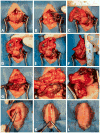Development of murine bariatric surgery models: lessons learned
- PMID: 29937006
- PMCID: PMC6298430
- DOI: 10.1016/j.jss.2018.04.022
Development of murine bariatric surgery models: lessons learned
Abstract
Roux-en-Y gastric bypass (RYGB) improves comorbidities such as diabetes and hypertension and lowers the risk of obesity-related cancers. To better understand the physiologic and genetic influences of bariatric surgery, a reliable murine model is needed that can be extended to genetically engineered mice. Given the complexity of these procedures, few researchers have successfully implemented these techniques beyond larger rodent models. The purpose of our study was to develop a technically feasible and reproducible murine model for RYGB and sleeve gastrectomy (SG). Mice were converted to liquid diet perioperatively without fasting and housed in groups on raised wire platforms. SG involved significant reduction of stomach volume followed by multilayer repair of the gastrotomy. RYGB procedure consisted of side-to-side, functional end-to-side bowel anastomoses and exclusion of the stomach medial to the gastroesophageal junction. Sham surgeries consisted of enterotomies and gastrotomy followed by primary repair without resection or rerouting. Survival after incorporation of the aforementioned techniques was 100% in the SG group and 41% in the RYGB group at 1 mo after surgery. Only 26% of RYGB mortality was attributed to leak, obstruction, or stricture; the majority of postoperative mortality was due to stress, dumping, or malnutrition. Much of the survival challenge for this surgical model was related to perioperative husbandry, which is to be expected given their small stature and poor response to stress. Utilization of the perioperative and surgical techniques described will increase survival and feasibility of these technically challenging procedures, allowing for a better understanding of mechanisms to explain the beneficial effects of bariatric surgery.
Keywords: Bariatric surgery; Murine model; Roux-en-Y gastric bypass.
Copyright © 2018 Elsevier Inc. All rights reserved.
Conflict of interest statement
Figures




Similar articles
-
Thirty-day outcomes of sleeve gastrectomy versus Roux-en-Y gastric bypass: first report based on Metabolic and Bariatric Surgery Accreditation and Quality Improvement Program database.Surg Obes Relat Dis. 2018 May;14(5):545-551. doi: 10.1016/j.soard.2018.01.011. Epub 2018 Jan 13. Surg Obes Relat Dis. 2018. PMID: 29551470
-
Tailoring Bariatric Surgery: Sleeve Gastrectomy, Roux-en-Y Gastric Bypass and Biliopancreatic Diversion with Duodenal Switch.J Laparoendosc Adv Surg Tech A. 2018 Aug;28(8):956-961. doi: 10.1089/lap.2018.0397. Epub 2018 Jul 30. J Laparoendosc Adv Surg Tech A. 2018. PMID: 30059264
-
Comparison of the incidence of cholelithiasis after sleeve gastrectomy and Roux-en-Y gastric bypass in obese patients: a prospective study.Surg Obes Relat Dis. 2015 Jul-Aug;11(4):779-84. doi: 10.1016/j.soard.2014.10.015. Epub 2014 Oct 23. Surg Obes Relat Dis. 2015. PMID: 25851775
-
Advances in the surgical treatment of morbid obesity.Mol Aspects Med. 2013 Feb;34(1):84-94. doi: 10.1016/j.mam.2012.10.006. Epub 2012 Oct 23. Mol Aspects Med. 2013. PMID: 23089054 Review.
-
Sleeve gastrectomy and Roux En Y gastric bypass: current state of metabolic surgery.Curr Opin Endocrinol Diabetes Obes. 2014 Oct;21(5):352-7. doi: 10.1097/MED.0000000000000099. Curr Opin Endocrinol Diabetes Obes. 2014. PMID: 25111943 Review.
Cited by
-
RYGB Is More Effective than VSG at Protecting Mice from Prolonged High-Fat Diet Exposure: An Occasion to Roll Up Our Sleeves?Obes Surg. 2021 Jul;31(7):3227-3241. doi: 10.1007/s11695-021-05389-8. Epub 2021 Apr 15. Obes Surg. 2021. PMID: 33856636
-
Surgical Mouse Models of Vertical Sleeve Gastrectomy and Roux-en Y Gastric Bypass: a Review.Obes Surg. 2019 Dec;29(12):4084-4094. doi: 10.1007/s11695-019-04205-8. Obes Surg. 2019. PMID: 31630327 Review.
-
Sex-specific differences in metabolic outcomes after sleeve gastrectomy and intermittent fasting in obese middle-aged mice.Am J Physiol Endocrinol Metab. 2022 Jul 1;323(1):E107-E121. doi: 10.1152/ajpendo.00017.2022. Epub 2022 Jun 6. Am J Physiol Endocrinol Metab. 2022. PMID: 35658544 Free PMC article.
-
Trends, Outcomes, and Impact of Early Discharge Following Bariatric Surgery: a Retrospective MBSAQIP Analysis of 748,955 Patients.Obes Surg. 2022 Aug;32(8):2572-2581. doi: 10.1007/s11695-022-06108-7. Epub 2022 May 27. Obes Surg. 2022. PMID: 35619047
References
-
- Bae J, Shade J, Abraham A, et al. Effect of Mandatory Centers of Excellence Designation on Demographic Characteristics of Patients Who Undergo Bariatric Surgery. JAMA Surg. 2015;150(7):644–648. - PubMed
-
- Skolnik NS, Ryan DH. Pathophysiology, epidemiology, and assessment of obesity in adults. J Fam Pract. 2014;63(7 Suppl):S3–S10. - PubMed
-
- Lavie CJ, McAuley PA, Church TS, Milani RV, Blair SN. Obesity and cardiovascular diseases: implications regarding fitness, fatness, and severity in the obesity paradox. J Am Coll Cardiol. 2014;63(14):1345–1354. - PubMed
Publication types
MeSH terms
Grants and funding
LinkOut - more resources
Full Text Sources
Other Literature Sources
Medical
Research Materials

